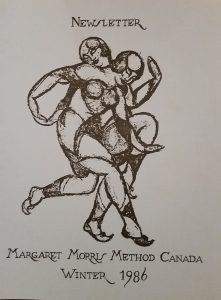
The Fergusson Gallery, Perth.
A fortnight ago I paid my first visit to the Fergusson Gallery, Perth, to begin assessing and listing the Margaret Morris Collection which is housed there. This is the first step towards what will eventually be full cataloguing, rehousing and conserving of the archival collection, and I enjoyed my introduction to the remarkable life of movement and dance pioneer Margaret Morris (1891-1980) and, what’s more, the astonishing story of her archive.
The collection encompasses an array of materials relating to Morris’ life and career as well as the organisation she established, Margaret Morris Movement (which expanded to become the International Association of Margaret Morris Movement). Things get a bit complicated – not to mention dramatic – once we start looking at the variety of people who have added to this collection over the years, and ensured its survival against the odds.

Margaret Morris, anatomical drawing of a hand. Courtesy of Culture Perth and Kinross.

Alhambra Theatre programme, 1928. Courtesy of Culture Perth and Kinross.

Margaret Morris reciting aged five, c.1904. Courtesy of Culture Perth and Kinross.
The earliest parts of the collection were amassed by Victoria Bright Morris, Margaret’s mother. She collected photographs, posters and promotional material relating to her daughter’s performing career (which began aged three, when Margaret would recite poetry and stories in both English and French). Margaret herself kept a lot of material relating to her life and work: programmes, brochures and posters from her famous summer schools, demonstrations and performances; lecture notes and anatomical drawings from her training as a physiotherapist, and voluminous correspondence with her mother, her husband the artist J.D. Fergusson and friends and associates, including numerous literary, musical and theatrical names. The archive also includes items originally created by or belonging to Margaret’s students and colleagues. One of them, Margaret’s personal secretary, dresser and costume maker, Isabel Jeayes, who stored the archive in her London home during the Second World War (when Margaret and Fergusson relocated to Glasgow). Here the first of many disasters struck the collection when it was damaged during the Blitz.
What survived the bombing was moved up to Glasgow, partly to Margaret’s home and partly to the premises of her Margaret Morris School. When J.D. Fergusson died in 1961, Margaret decided to close the School and sell the building. One of her former students, the dancer Jim Hastie, received an urgent call to tell him that the archive was being rapidly disposed of in three skips outside the building. Jim travelled by bus overnight from London and spent two days rescuing as much material as he could before the refuse collectors arrived, storing the surviving material at Margaret’s home.

Margaret Morris Method Canada newsletter, winter 1986. Courtesy of Culture Perth and Kinross.
More upheaval followed during the 1970s when Margaret relocated back to the south of England. Hastie took the archive in to his own home in Glasgow before moving it to the Head Office of Margaret Morris Movement (also in Glasgow) following Margaret’s death in 1980. Catastrophe struck when burglars entered the building and set it on fire. The surviving items were moved to another part of the building only to be damaged again (mainly by water this time) when the adjoining hotel was also set on fire. At this point, Hastie took the archive back into his home before donating it to Perth and Kinross Council (now Culture Perth and Kinross) in 2010. Jim, who became Life President and Artistic Director of the International Association of Margaret Morris Movement, added many items to the collection relating to his own career as well as the operation of the organisation.
The archive is now housed in a building dedicated to the work of J.D. Fergusson and Margaret Morris, and forms part of a wider set of collections of artwork, costumes, sculpture and furniture (as well as Fergusson’s own archive). My first tasks are to begin to untangle the complicated provenance of Morris’ archive and identify those items requiring urgent conservation treatment. Thanks to Wellcome Trust funding, Margaret Morris’ archive will be made fully accessible for many decades to come, but it is thanks to all those who have gone before that it is here today at all.
Clare Button
Project Archivist
With grateful acknowledgement to Jim Hastie’s own reminiscences, ‘The Story of the Margaret Morris Archive.’
